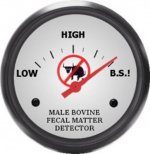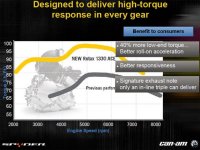So I just got my first full service oil change at 3,000 miles on my 2016 F3L. When he finished the mechanic came out and gave me the results. Everything was good he said but I need to give you some advice. The printout shows that you have a lot of run time less than 3,000 rpm. I said yes most of my driving is around town going 35 - 40 mph (900 out of my 3000 miles at interstate speeds). He said well you need to hold off shifting until at least 3500 - 4000 rpm. So I said why? He informs me that by shifting at the "lower" rpms and continuing to ride at less than 3000 rpm (I actually shift gears @ 3000 - 3500 normally) I'm preventing sufficient oil pressure build up to fully engage all the plates in the clutch. This allows slippage and the heat build up can cause warping and early clutch wear out.
So thinking he's giving me advice for the 998 and not wanting to tell him he's wrong I said "well I know on the 998 the clutch didn't engage until around 3200 rpm but the 1330 engages around 1100rpm. Also if you select ECO Mode (I don't) it recommends shifting around 2200 rpm. So what you're telling me doesn't make a lot of sense to me. So without even considering what I had just said He said "well all I can tell you is what BRP tells me to recommend". I could see I wasn't getting anywhere and decided to let it go. He was getting that "I can't believe you're questioning me" look in his eyes.
And to clarify none of the discussion was concerning varying rpm during the break in period.
Rick
So thinking he's giving me advice for the 998 and not wanting to tell him he's wrong I said "well I know on the 998 the clutch didn't engage until around 3200 rpm but the 1330 engages around 1100rpm. Also if you select ECO Mode (I don't) it recommends shifting around 2200 rpm. So what you're telling me doesn't make a lot of sense to me. So without even considering what I had just said He said "well all I can tell you is what BRP tells me to recommend". I could see I wasn't getting anywhere and decided to let it go. He was getting that "I can't believe you're questioning me" look in his eyes.
And to clarify none of the discussion was concerning varying rpm during the break in period.
Rick


